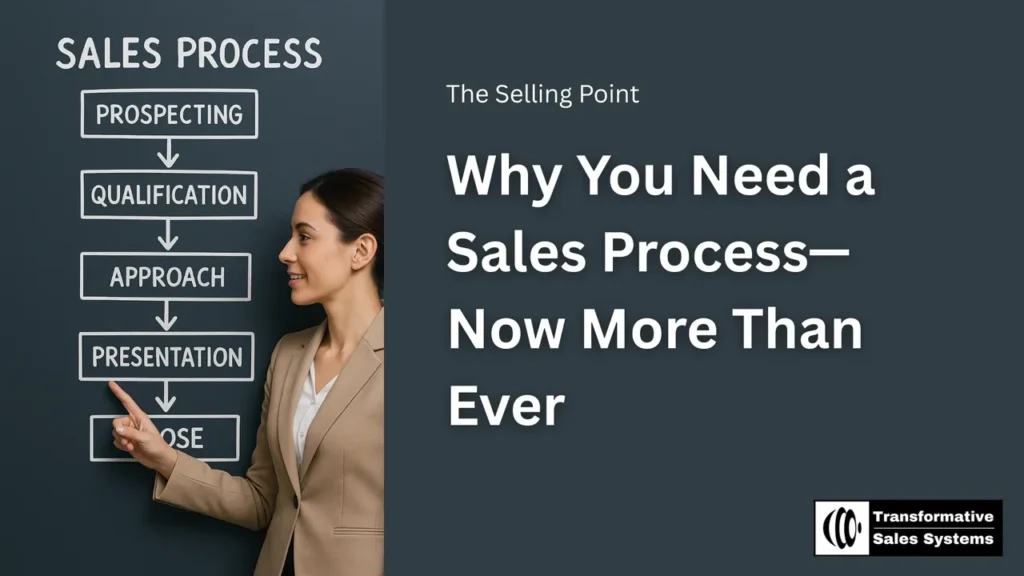Consider the following definition:
Process /ˈpräˌses,ˈprōˌses/ — a series of actions or steps taken in order to achieve a particular end.
Sound like something useful when it comes to sales? Now consider the antonyms of “process”:
Disorganization. Chaos. Confusion. Disarray. Disorder. Inactivity. Idleness. Dormancy.
Does any of that sound like your current sales efforts?
If your honest answer is “yes”—and for many, it is—then the answer to the original question is loud and clear: YES, you need a sales process.
What Is a Sales Process, Really?
It’s not a buzzword to be thrown around willy nilly. It’s a repeatable set of actions that move a deal from start to close. And the goal? A closed sale—not just activity, not just effort, but results.
Every company and market is different, but the fundamentals of a strong sales process are the same. Here’s a basic version I use and teach—one that applies across most industries.
1. Identify a Qualified Prospect
You’re looking for someone who can benefit from what you offer. This might be an existing customer, a referral, someone you cold-called, or a lead from your marketing. But don’t chase ghosts. If they don’t have a real problem you can solve, move on.
2. Understand Their Needs (and What They Think They Need)
This step is about digging deep. What are their issues, concerns, or goals—spoken or unspoken? Your job is to uncover the truth, even if it’s buried under assumptions. Sometimes what a customer wants isn’t what they need. That’s your opening.
If you can’t solve the problem with confidence, be honest, and walk away. Don’t waste their time—or yours—on a deal that’s going nowhere.
3. Identify and Frame the Right Solution
This step only works if you’ve done your homework. You need to be able to show them:
“This solves your real problem—and here’s why.”
Chances are you’ll have to guide them. Many prospects don’t understand their own situation clearly. You do—because you took the time to learn.
4. Don’t Lead with Price
If the conversation is only about price, you’re already in a bad spot. You’ll end up in a race to the bottom, and no one wins that game. If price is all they want to discuss, decide whether you’re willing to play that game—or if it’s time to walk away.
5. Gauge Real Commitment
Before you quote anything, find out if they’re actually ready to act. Are they willing to invest time, money, and attention? If not, don’t kid yourself into thinking a proposal will magically change that.
Without commitment, you’re just doing free consulting.
6. Secure Verbal Buy-In
At this point, the solution is clear, and the customer agrees that it’s the right move. This is when you get the green light—before you even talk numbers. You’ve earned their trust, and they’re bought in.
7. Now—and Only Now—Submit a Proposal
A proposal is a formality at this point. It’s not a pitch; it’s paperwork. If you’ve worked the process correctly, this step should be simple.
The Final Word
This isn’t just theory. It’s what I do and what I teach. And it works—because it gives you structure, clarity, and a way to see when a deal is truly alive… or already dead.
If your team is stuck in disarray, if deals are stalling, or if you’re constantly hearing “your price is too high,” there’s a good chance the real issue is a lack of process.
That’s fixable.
If you want help building or leading a sales process that actually drives results, let’s talk.
We do this every day at Transformative Sales Systems—and we can do it for you.
Want to see what a strong sales manager could do for your business? Let’s talk.
https://calendly.com/anthony-nicks/can-fractional-sales-management-help-me
For more information or to discuss your particular situation contact us at the following…
765-623-5623
To learn more about how Fractional Sales Management can help a small and midsize enterprise (SME) click the following…
https://transformativesalessystems.com/fractional-sales-manager

